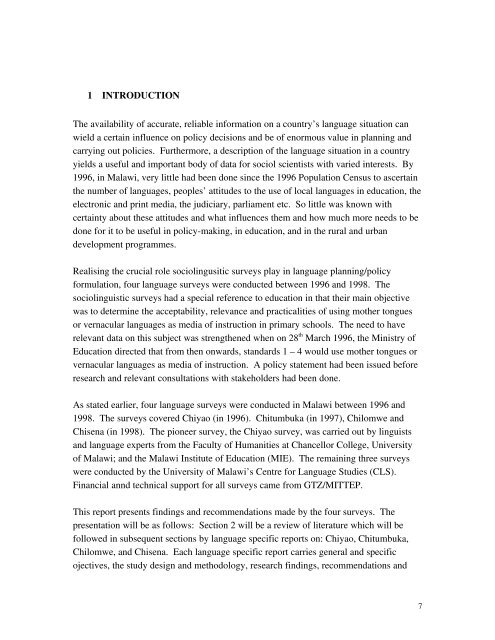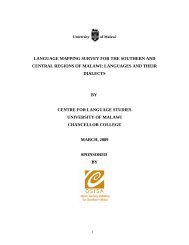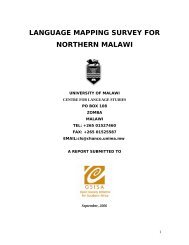SOCIOLOLINGUISTIC SURVEYS - Centre for Language Studies
SOCIOLOLINGUISTIC SURVEYS - Centre for Language Studies
SOCIOLOLINGUISTIC SURVEYS - Centre for Language Studies
Create successful ePaper yourself
Turn your PDF publications into a flip-book with our unique Google optimized e-Paper software.
1 INTRODUCTION<br />
The availability of accurate, reliable in<strong>for</strong>mation on a country’s language situation can<br />
wield a certain influence on policy decisions and be of enormous value in planning and<br />
carrying out policies. Furthermore, a description of the language situation in a country<br />
yields a useful and important body of data <strong>for</strong> sociol scientists with varied interests. By<br />
1996, in Malawi, very little had been done since the 1996 Population Census to ascertain<br />
the number of languages, peoples’ attitudes to the use of local languages in education, the<br />
electronic and print media, the judiciary, parliament etc. So little was known with<br />
certainty about these attitudes and what influences them and how much more needs to be<br />
done <strong>for</strong> it to be useful in policymaking, in education, and in the rural and urban<br />
development programmes.<br />
Realising the crucial role sociolingusitic surveys play in language planning/policy<br />
<strong>for</strong>mulation, four language surveys were conducted between 1996 and 1998. The<br />
sociolinguistic surveys had a special reference to education in that their main objective<br />
was to determine the acceptability, relevance and practicalities of using mother tongues<br />
or vernacular languages as media of instruction in primary schools. The need to have<br />
relevant data on this subject was strengthened when on 28 th March 1996, the Ministry of<br />
Education directed that from then onwards, standards 1 – 4 would use mother tongues or<br />
vernacular languages as media of instruction. A policy statement had been issued be<strong>for</strong>e<br />
research and relevant consultations with stakeholders had been done.<br />
As stated earlier, four language surveys were conducted in Malawi between 1996 and<br />
1998. The surveys covered Chiyao (in 1996). Chitumbuka (in 1997), Chilomwe and<br />
Chisena (in 1998). The pioneer survey, the Chiyao survey, was carried out by linguists<br />
and language experts from the Faculty of Humanities at Chancellor College, University<br />
of Malawi; and the Malawi Institute of Education (MIE). The remaining three surveys<br />
were conducted by the University of Malawi’s <strong>Centre</strong> <strong>for</strong> <strong>Language</strong> <strong>Studies</strong> (CLS).<br />
Financial annd technical support <strong>for</strong> all surveys came from GTZ/MITTEP.<br />
This report presents findings and recommendations made by the four surveys. The<br />
presentation will be as follows: Section 2 will be a review of literature which will be<br />
followed in subsequent sections by language specific reports on: Chiyao, Chitumbuka,<br />
Chilomwe, and Chisena. Each language specific report carries general and specific<br />
ojectives, the study design and methodology, research findings, recommendations and<br />
7





